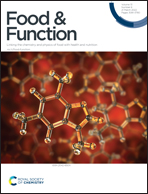Dihydromyricetin improves meat quality and promotes skeletal muscle fiber type transformations via AMPK signaling in growing–finishing pigs†
Abstract
As the demand of consumers for good meat quality is increasing, there is more interest in improving pork quality by nutritional regulation. Dihydromyricetin (DHM), a group of bioactive flavonoids, exhibits excellent biological functions and pharmacological activities. This study aimed to investigate whether dietary DHM supplementation in growing–finishing pigs could provide high-quality pork. A total of 24 healthy castrated Duroc × Landrace × Yorkshire (DLY) pigs with an average body weight of 26.95 ± 0.26 kg were randomly divided into four groups (basal diet and a basal diet supplemented with 100, 300 and 500 mg kg−1 DHM) with 6 duplicates and one pig per replicate. The growth performance, carcass traits and pork quality of growing–finishing pigs were detected. Then, tandem mass tag (TMT) based quantitative proteomics, western blotting and real-time quantitative polymerase chain reaction (RT-qPCR) were used to explore the regulatory mechanism of DHM on pork quality. The results showed that DHM decreased the feed to gain ratio (F/G) and improved the sensory quality (shear force and meat color) and nutritional value (crude protein content and amino acid composition) of pork in growing–finishing pigs. Totally 22 differentially expressed proteins were identified, among which the down-regulated heat shock protein-β1 (HSPB1) and up-regulated Troponin C-slow (TNNC1) contributed towards explaining the positive effect of DHM on the tenderness and meat color of pork. GO enrichment analysis revealed that better meat color was also linked to higher levels of oxidative metabolism and hemoglobin complexes in pork. Western blotting and RT-qPCR analysis showed that DHM induced a muscle fiber type transformation from fast-switch to slow-switch by activating the AMP-activated protein kinase (AMPK) signal, thereby improving the pork quality. Taken together, our findings provide effective evidence for the application of DHM in high-quality pork production.



 Please wait while we load your content...
Please wait while we load your content...